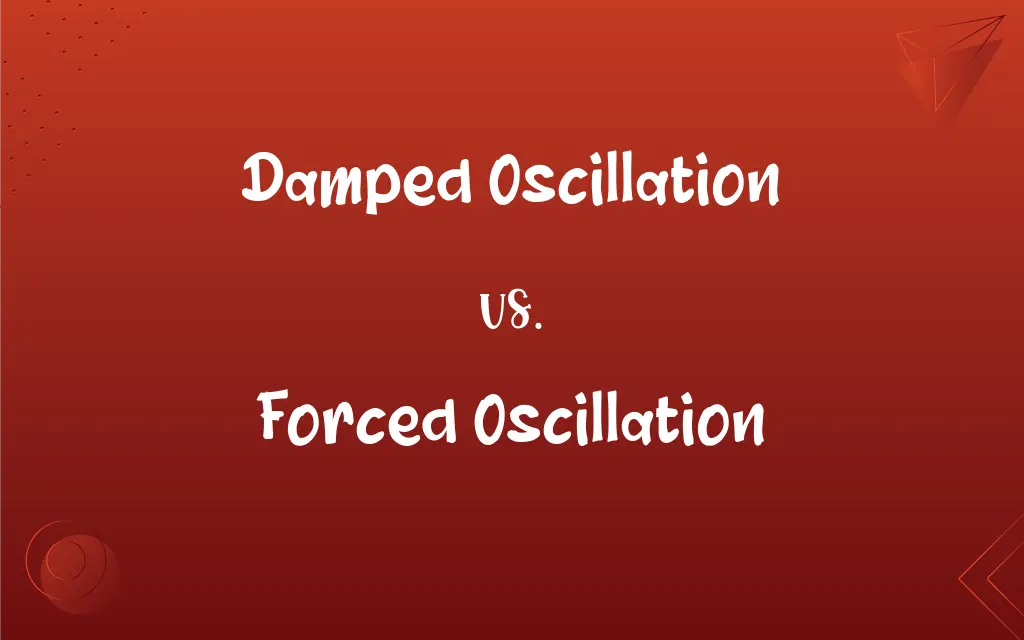Damped Oscillation vs. Forced Oscillation: What's the Difference?
Edited by Aimie Carlson || By Janet White || Published on January 28, 2024
Damped oscillation involves gradual amplitude reduction, while forced oscillation is sustained or amplified by external forces.

Key Differences
Damped oscillation refers to a decrease in amplitude over time due to energy loss, typically from friction or resistance. In contrast, forced oscillation occurs when an external force continuously drives the system, often leading to a steady-state oscillation at the force's frequency.
In damped oscillations, energy is gradually lost to the surroundings, leading to a reduction in motion. Forced oscillation, however, involves continuous energy input from an external source, maintaining or increasing the system's motion.
The amplitude of a damped oscillation consistently decreases over time, heading towards zero. For forced oscillations, the amplitude can reach a constant value or vary depending on the frequency and strength of the external force.
The frequency of a damped oscillation is determined by the system's natural properties but can change due to damping. In forced oscillations, the frequency matches the external force, and resonance can occur when this frequency aligns with the system's natural frequency.
Damped oscillation is common in mechanical systems like shock absorbers, where energy dissipation is desired. Forced oscillation is seen in systems like bridges or buildings subjected to periodic forces like wind or earthquakes.
ADVERTISEMENT
Comparison Chart
Energy Dynamics
Energy is lost over time
Energy is added from an external source
Amplitude Change
Amplitude decreases gradually
Amplitude can be constant or controlled
Frequency
Determined by the system, altered by damping
Matches the frequency of the external force
Resonance
Less likely due to decreasing energy
Possible at specific frequencies of external force
Common Examples
Vehicle suspension systems
Buildings swaying due to consistent wind patterns
ADVERTISEMENT
Damped Oscillation and Forced Oscillation Definitions
Damped Oscillation
Motion that diminishes due to resistive forces.
The damped oscillation of the spring was evident as it stopped bouncing rapidly.
Forced Oscillation
Oscillation at the frequency of an external force.
The tuning fork entered forced oscillation at the speaker's sound frequency.
Damped Oscillation
Gradual decrease in the amplitude of oscillation.
The swinging pendulum slowly came to a halt due to damped oscillation.
Forced Oscillation
Motion sustained or amplified by external influences.
The child's swing exhibited forced oscillation due to the parent's pushes.
Damped Oscillation
A reducing oscillatory motion in a mechanical system.
The car's damped oscillation provided a smooth ride over bumpy roads.
Forced Oscillation
Oscillation maintained by an external periodic force.
The forced oscillation of the bridge was caused by consistent wind gusts.
Damped Oscillation
Oscillation where energy is lost over time.
In a damped oscillation, the vibrations of the guitar string faded quickly.
Forced Oscillation
A system's response to a continuous external force.
The forced oscillation of the building was triggered by seismic waves.
Damped Oscillation
Oscillation that experiences energy dissipation.
The damped oscillation of the clock's pendulum ensured accurate timekeeping.
Forced Oscillation
Periodic motion driven by an outside force.
In the lab, the pendulum's forced oscillation was due to an electromagnetic field.
FAQs
Does forced oscillation require constant energy input?
Yes, to maintain the motion, continuous energy input is necessary.
How do shock absorbers use damped oscillation?
They dissipate energy from motion, reducing vibrations.
What's the role of damping in forced oscillation?
Damping can limit the amplitude in forced oscillation.
How does resonance affect forced oscillation?
Resonance can significantly increase the amplitude.
Can damped oscillation ever stop completely?
Yes, damped oscillation can cease when all energy is dissipated.
Can forced oscillation occur in electrical circuits?
Yes, with external periodic electrical signals.
What causes damped oscillation?
Energy loss through friction or resistance leads to damped oscillation.
What is an example of forced oscillation in nature?
Ocean tides influenced by the moon's gravity are a natural example.
What happens to damped oscillation at critical damping?
The system returns to equilibrium without oscillating.
Can forced oscillation lead to structural failure?
Yes, especially if resonance occurs at structural frequencies.
How is damped oscillation modeled in physics?
Often with differential equations incorporating damping terms.
What are the dangers of forced oscillation in engineering?
It can lead to unforeseen stress and potential structural damage.
Can we control the rate of damped oscillation?
Yes, by altering the damping characteristics of the system.
Do all systems show damped oscillation naturally?
Most mechanical systems will show some form of damping.
How do clocks utilize damped oscillation?
Pendulum clocks use it for accurate timekeeping.
What distinguishes forced oscillation in musical instruments?
It's typically driven by human interaction or electronic means.
Can damped oscillation be completely eliminated?
Not entirely, but it can be minimized in well-designed systems.
What role does frequency play in forced oscillation?
The system oscillates at the frequency of the external force.
Does the amplitude in forced oscillation always increase?
Not always; it depends on the damping and the driving force.
Is it possible to have both damped and forced oscillation in one system?
Yes, many real-world systems exhibit both.
About Author
Written by
Janet WhiteJanet White has been an esteemed writer and blogger for Difference Wiki. Holding a Master's degree in Science and Medical Journalism from the prestigious Boston University, she has consistently demonstrated her expertise and passion for her field. When she's not immersed in her work, Janet relishes her time exercising, delving into a good book, and cherishing moments with friends and family.
Edited by
Aimie CarlsonAimie Carlson, holding a master's degree in English literature, is a fervent English language enthusiast. She lends her writing talents to Difference Wiki, a prominent website that specializes in comparisons, offering readers insightful analyses that both captivate and inform.






































































